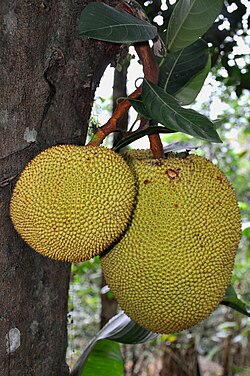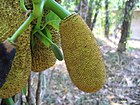Note: This is a project under development. The articles on this wiki are just being initiated and broadly incomplete. You can Help creating new pages.
Difference between revisions of "Artocarpus heterophyllus - Panasa, Jackfruit"
(→Parts Used) |
|||
| Line 6: | Line 6: | ||
==Parts Used== | ==Parts Used== | ||
| − | {{Parts Used|Bark}}, {{Parts Used|Leaf}}, {{Parts Used|Heartwood}}, {{Parts Used|Seeds}}, {{Parts Used|Root}}, {{Parts Used|Stem}} | + | {{Parts Used|Bark}}, {{Parts Used|Leaf}}, {{Parts Used|Heartwood}}, {{Parts Used|Seeds}}, {{Parts Used|Root}}, {{Parts Used|Stem}}<ref name="Karnataka Medicinal Plants"/> |
==Chemical Composition== | ==Chemical Composition== | ||
| Line 68: | Line 68: | ||
==References== | ==References== | ||
| − | |||
<references> | <references> | ||
<ref name="Uses">[https://easyayurveda.com/2017/05/24/jackfruit-uses/ Uses]</ref> | <ref name="Uses">[https://easyayurveda.com/2017/05/24/jackfruit-uses/ Uses]</ref> | ||
| Line 74: | Line 73: | ||
<ref name="Common names">[http://envis.frlht.org/bot_search Vernacular names]</ref> | <ref name="Common names">[http://envis.frlht.org/bot_search Vernacular names]</ref> | ||
<ref name="Cultivation details">[http://tropical.theferns.info/viewtropical.php?id=Artocarpus+heterophyllus Cultivation details]</ref> | <ref name="Cultivation details">[http://tropical.theferns.info/viewtropical.php?id=Artocarpus+heterophyllus Cultivation details]</ref> | ||
| + | <ref name="Karnataka Medicinal Plants">”Karnataka Medicinal Plants Volume-3” by Dr.M. R. Gurudeva, Page No.1253, Published by Divyachandra Prakashana, #6/7, Kaalika Soudha, Balepete cross, Bengaluru</ref> | ||
</references> | </references> | ||
Revision as of 12:17, 31 March 2022
Panasa is a very important multipurpose tree. It is particularly valued for its fruit. The tree is widely cultivated in tropical regions, especially southeast Asia and Brazil.
Contents
- 1 Uses
- 2 Parts Used
- 3 Chemical Composition
- 4 Common names
- 5 Properties
- 6 Habit
- 7 Identification
- 8 List of Ayurvedic medicine in which the herb is used
- 9 Where to get the saplings
- 10 Mode of Propagation
- 11 How to plant/cultivate
- 12 Commonly seen growing in areas
- 13 Photo Gallery
- 14 References
- 15 External Links
Uses
Wound healing, Inflammation, Skin diseases, Ulcers, Bleeding [1]
Parts Used
Bark, Leaf, Heartwood, Seeds, Root, Stem[2]
Chemical Composition
Common names
| Language | Common name |
|---|---|
| Kannada | Halasina hannu |
| Hindi | Kathal |
| Malayalam | Plavu, Chakka |
| Tamil | Palamaram |
| Telugu | Panasa |
| Marathi | NA |
| Gujarathi | NA |
| Punjabi | NA |
| Kashmiri | NA |
| Sanskrit | Apuspaphala, Kantakiphala, Panasa |
| English | Jackfruit |
Properties
Reference: Dravya - Substance, Rasa - Taste, Guna - Qualities, Veerya - Potency, Vipaka - Post-digesion effect, Karma - Pharmacological activity, Prabhava - Therepeutics.
Dravya
Rasa
Madhura (Sweet), Kashaya (Astringent)
Guna
Guru (Heavy), Snigdha (Slimy)
Veerya
Sheeta (cold)
Vipaka
Madhura (Sweet)
Karma
Pitta, Vata
Prabhava
Habit
Identification
Leaf
| Kind | Shape | Feature |
|---|---|---|
| Simple | Alternate | 8-23 x 3-13 cm, obovate, obovate-oblong, or elliptic-ovate, apex acute or obtuse, base acute, round or cuneate, margin entire, glabrous and shining above and scabrous beneath. |
Flower
| Type | Size | Color and composition | Stamen | More information |
|---|---|---|---|---|
| Unisexual | Spikes | Greenish yellow | 1 | Male from young branches, catkin narrow-cylindric; perianth 2-lobed, puberulous; stamen 1. Flowering from February to June |
Fruit
| Type | Size | Mass | Appearance | Seeds | More information |
|---|---|---|---|---|---|
| Sorosis | 30-45 x 20-25 cm | Oblong, tuberculate, tubercles conical yellowish-green, fruiting perianth yellow to light orange, fleshy | Seeds 10-12 x 8-10 mm, elliptic-oblong, smooth, glossy | Fruiting from February to June |
Other features
List of Ayurvedic medicine in which the herb is used
Where to get the saplings
Mode of Propagation
How to plant/cultivate
Under suitable conditions, germination begins within 10 days, and 80-100% germination is achieved within 35-40 days after sowing.[5]
Commonly seen growing in areas
Tropical area, Sub tropical area
Photo Gallery
References
- ↑ Uses
- ↑ ”Karnataka Medicinal Plants Volume-3” by Dr.M. R. Gurudeva, Page No.1253, Published by Divyachandra Prakashana, #6/7, Kaalika Soudha, Balepete cross, Bengaluru
- ↑ Vernacular names
- ↑ Botonic description
- ↑ Cultivation details
External Links
- Ayurvedic Herbs known to be helpful to treat Wound healing
- Ayurvedic Herbs known to be helpful to treat Inflammation
- Ayurvedic Herbs known to be helpful to treat Skin diseases
- Ayurvedic Herbs known to be helpful to treat Ulcers
- Ayurvedic Herbs known to be helpful to treat Bleeding
- Herbs with Bark used in medicine
- Herbs with Leaf used in medicine
- Herbs with Heartwood used in medicine
- Herbs with Seeds used in medicine
- Herbs with Root used in medicine
- Herbs with Stem used in medicine
- Herbs with common name in Kannada
- Herbs with common name in Hindi
- Herbs with common name in Malayalam
- Herbs with common name in Tamil
- Herbs with common name in Telugu
- Herbs with common name in Sanskrit
- Herbs with common name in English
- Habit - Tree
- Index of Plants which can be propagated by Seeds
- Index of Plants which can be propagated by Cuttings
- Herbs that are commonly seen in the region of Tropical area
- Herbs that are commonly seen in the region of Sub tropical area
- Herbs
- Moraceae





